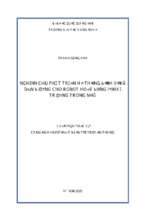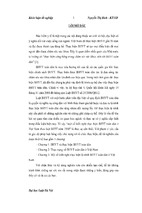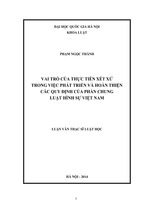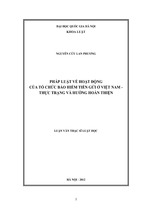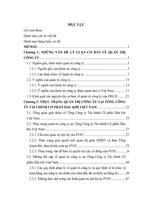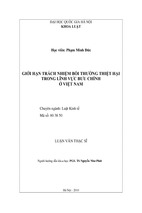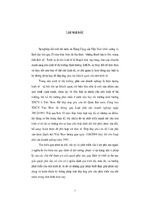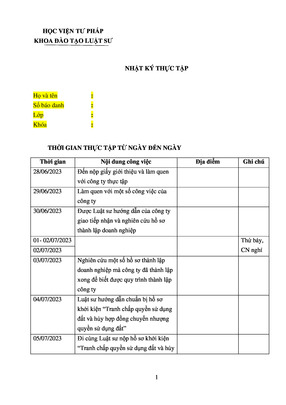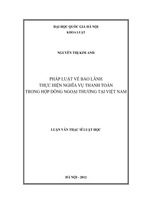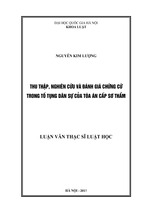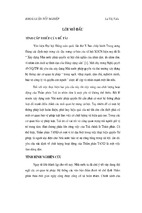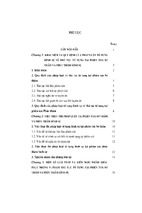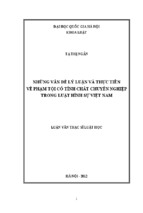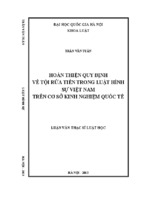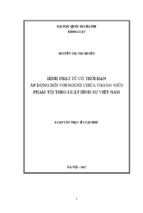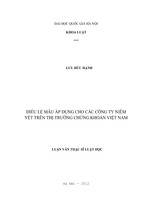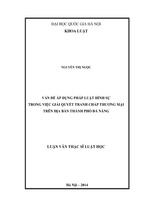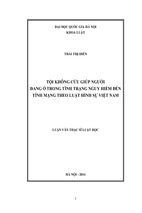HO CHI MINH CITY UNIVERSITY OF LAW
FACULTY OF INTERNATIONAL LAW
-----------***------------
TRAN BAO NGAN
Student ID: 1651101030091
SOME REGULATORY CHALLENGES ARISING
FROM THE OPERATION OF FOREIGN
INVESTORS PROVIDING RIDE-HAILING
SERVICE UNDER THE SHARING ECONOMY
MODEL IN VIETNAM,
BRITISH EXPERIENCE AND
RECOMMENDATIONS.
BACHELOR’S THESIS
School Year: 2017 – 2022
Supervisor:
Dr. Nguyen Thi Hoa
Ho Chi Minh City – Year 2022
DECLARATION
I hereby declare that the thesis "Some regulatory challenges arising from the
operation of foreign investors providing ride-hailing service under the sharing economy
model in Vietnam, British experience and recommendations" is the result of my research,
conducted under the scientific supervision of Dr. Nguyen Thi Hoa, ensuring honesty and
compliance with the rules on citation and annotated bibliography. I take full
responsibility for this declaration.
Ho Chi Minh City, June 29, 2022
Tran Bao Ngan
LIST OF ABBREVIAITONS
CIEM
Central Institute for Economic
Management
Civil Code
Civil Code No. 91/2015/QH13, dated
November 24, 2015
Decree 10/2020
Decree No. 10/2020/ND-CP on Auto
Transport Business and Conditions for
Auto Transport Business. Dated January
17, 2020
Decree 126/2020
Decree No. 126/2020/ND-CP Elaboration
of the Law in Tax Administration, dated
October 19, 2020
Decree 31/2021
Decree No. 31/2021/ND-CP Elaboration
of Some Articles of the Law on
Investment, dated March 26, 2021
Labor Code
Labor Code No. 45/2019/QH14, dated
November 20, 2019
Law on Investment
Law on Investment No. 61/2020/QH14,
dated June 17, 2020
UK
United Kingdom
VAT
Value-add tax
WTO
World Trade Organization
TABLE OF CONTENTS
INTRODUCTION .......................................................................................................... 1
CHAPTER 1: AN OVERVIEW OF THE SHARING ECONOMY AND ITS
CURRENT STATUS IN VIETNAM ............................................................................ 9
1.1. Overview of the sharing economy...................................................................... 9
1.1.1. Definition and characteristics of the sharing economy .................................. 9
1.1.2. Some forms of business in the sharing economy ......................................... 13
1.2. An overview of business activities of business entities under the sharing
economy concept in Vietnam................................................................................... 18
1.2.1. Operational status of business entities under the sharing economy concept
in Vietnam .............................................................................................................. 18
1.2.2. The impact of the sharing economy on the overall economy ...................... 21
CONCLUSION OF CHAPTER 1 .............................................................................. 23
CHAPTER 2: MARKET ACCESS CONDITIONS FOR FOREIGN INVESTORS
PROVIDING RIDE-HAILING SERVICE ............................................................... 25
2.1. An overview of market access for foreign investors ...................................... 25
2.2. Business line identification ............................................................................... 28
2.3. Specific market access conditions for foreign investors providing the road
passenger transport services. .................................................................................. 29
2.3.1. Holding of charter capital by foreign investors ........................................... 29
2.3.2. Investment methods ..................................................................................... 30
2.3.3. Scope of investment ..................................................................................... 30
2.3.4. Capacity of investors and partners participating in investment activities and
other conditions ...................................................................................................... 31
CONCLUSION OF CHAPTER 2 .............................................................................. 33
CHAPTER 3: SOME REGULATORY ISSUES ARISING FROM THE
OPERATION OF FOREIGN INVESTORS PROVIDING RIDE-HAILING
SERVICE ...................................................................................................................... 35
3.1. The essentials of a legal framework for the sharing economy model........... 35
3.2. Some regulatory issues arising from the operation of foreign investors
providing ride-hailing services in Vietnam and the UK ....................................... 37
3.2.1. Employment issue ........................................................................................ 37
3.2.2. Tax issue....................................................................................................... 46
CONCLUSION OF CHAPTER 3 .............................................................................. 55
CONCLUSION OF THESIS ....................................................................................... 57
1
INTRODUCTION
1. Rationale
“The sharing economy phenomenon proved to be more than just a frail and
temporary trend and has been capable of overturning competition across the globe.
Within the wide variety of organizations that have flourished based on the concept of
“sharing” underutilized assets, a group of internet-based platform businesses have been
thriving in many different industry sectors and internationally.”1 According to a Pwc’s
survey, five major industries, including tourism, transportation, finance, human
resources, online music and video, which apply the sharing economy model, have the
potential to increase global revenue from $15 billion in 2014 to approximately $335
billion by 2025. One-third of Europe's population and seventy-two percent of North
America's population have used services via shared platforms. This demonstrates that
the potential for future global growth of the sharing economy is enormous. In Vietnam,
according to a recent study by the Department for National Economic Issues under the
Ministry of Planning and Investment, sharing economy is a new trend that goes hand-inhand with the revolution in information technology, becoming one of the key pillars of
the digital economy, and is the primary concern of entrepreneurs and start-ups in many
countries. Initially, the sharing economy concept has begun to attract attention from
2014, as a result of Uber and Grab’s market entry. In 2019, there were approximately
sixty sharing economy businesses currently active in Vietnam, providing services
ranging from transportation to lodging, finance, and labor. For instance, Airbnb, an
accommodation sharing platform firm, registered 1,000 rooms to be shared in Vietnam
Belk (2014) and Möhlmann (2015), as cited in Parente, R. C., Geleilate, J. M. G., and Rong, K. (2018), “The
sharing economy globalization phenomenon: A research agenda”, Journal of International Management, 24(1),
p.1.
1
2
in 2015; by 2018, this number had risen to 40,800 rooms, accommodating over 400,000
people annually.2,3,4
Although there are numerous foreign investors operating and thriving under the
concept of the sharing economy in Vietnam, and the government also encourages this
growth,5 the absence of a suitable legal framework for the operation of foreign ridehaling platform providers results in many regulatory challenges such as tax,
employment, etc. Therefore, the author deems it necessary to address these issues and
propose recommendations based on experience from foreign laws.
2. Literature review
The concept of sharing economy piques the interest of various academics, thus,
there are a great number of documents have been written about this topic, both in
Vietnam and throughout the world. Some notable research is summarized in the below
section.
2.1. Vietnamese materials
Phạm Khánh Nam (2021), “Mô hình kinh tế chia sẻ: các vấn đề quản lý ở Việt
Nam” (The Sharing Economy: Governance Issues in Vietnam), UEH Digital Repository:
This article provides the definition of the sharing economy, how it functions, and how to
limit its unwanted effects while promoting its growth to contribute to the development
of Vietnam in the context of the Industrial Revolution 4.0. Particularly, the article
focuses on the analysis of the passenger transport business of technology firms to
Phạm Khánh Nam (2021), “Mô hình kinh tế chia sẻ: các vấn đề quản lý ở Việt Nam” (The Sharing Economy:
Governance Issues in Vietnam), UEH Digital Repository, p. 79.
3
Trần Thị Hằng (2019), Development of sharing economy in Vietnamese in the context of the industrial revolution
4.0 and some recommendations, Journal of Science and Technology - Hanoi University of Industry, No. 54, 2019,
p. 89.
4
Đỗ Thị Nhung, “Phát triển mô hình kinh tế chia sẻ ở Việt Nam và một số đề xuất” (Developing sharing economy
model in Vietnam and some recommendations), Financial Journal Online, dated May 19, 2018,
https://tapchitaichinh.vn/nghien-cuu--trao-doi/trao-doi-binh-luan/phat-trien-mo-hinh-kinh-te-chia-se-o-viet-namva-mot-so-de-xuat-139063.html, assessed on May 20, 2022.
5
On August 12, 2019, Prime Minister Nguyen Xuan Phuc signed Decision No. 999/QD-TTg giving approval for
Scheme for Development of Sharing Economy.
2
3
highlight the common issues associated with the sharing economy model and
recommend appropriate management strategies.
Hà Thị Thanh Bình (2021), “Kinh tế chia sẻ và sự điều chỉnh của pháp luật”
(Sharing economy and the regulation of laws), Vietnamese Journal of Legal Sciences,
02(141): This article analyzes the characteristics of the sharing economy and advocates
the need for the regulation of this business model. In addition, the author examines and
provides suggestions as to the content and extent to which the law should control the
sharing of underutilized resources. Also, the article analyzes and proposes certain legal
solutions for participants’ obligations, tax administration, and worker protection in the
sharing economy. The recommendation from this article is a good source for legislators
to improve the law to catch up with the development of the economy.
Chu Thị Hoa (2021), “Kinh tế chia sẻ và quyền tự do kinh doanh” (Sharing
economy and business freedom), Electronic newspaper of the Ministry of Justice: In this
paper, the author introduces and analyzes the realization of business independence in the
sharing economy model, thereby fostering the growth of this industry in Vietnam.
Dương Kim Thế Nguyên and Huỳnh Thiên Tứ (2021), “Kinh tế chia sẻ và dịch
vụ kết nối: Nhu cầu điều chỉnh về mặt pháp lý trong bối cảnh chuyển đổi số ở Việt Nam”
(Sharing economy and connected services: legal adjustment needs in the context of
digital transformation in Vietnam), Vietnamese Journal of Legal Sciences, 04(143): The
study analyzes various trends in the growth of the sharing economy and makes a
compelling case for the necessity to enact rules on these subjects. The authors then
recommend amending Vietnamese law to cover the sharing economy development
trends and intermediary service providers' activities.
Lê Thị Thúy Nga (2021), “Hoàn thiện pháp luật thuế về kinh tế chia sẻ tại Việt
Nam” (Perfecting tax laws on sharing economy in Vietnam), Economy & Forecast
Review Online, 16(770): In the context of industrial Revolution 4.0, accessing and
4
mastering the application of science and technology, especially information technology,
to the management, exploitation, and operation of sharing economy activities is an
inevitable tendency. However, the current issue is how to properly manage and
"stimulate" the development of the sharing economy, which is a difficult issue for many
nations, including Vietnam. The article focuses on clarifying several aspects of tax
legislation and tax administration in Vietnam for the sharing economy model.
Trần Thị Việt Hà (2020), “Một số vấn đề pháp lý đặt ra đối với quy định phát
triển mô hình kinh tế chia sẻ ở Việt Nam hiện nay” (Several legal concerns raised about
Vietnam's current sharing economy legislation), Vietnamese Journal of Legal Sciences,
04(43): The article provides an overview of sharing economy as well as its current status
in Vietnam. Based on that, the author demonstrates the necessity of completing the legal
framework for the sharing economy model in order to foster its development and limit
its possible negative effects on social life, participants of this model, and the overall
economy.
Trần Thi Hằng (2019), "Phát triển kinh tế chia sẻ tại Việt Nam trong bối cảnh
Cách mạng Công nghiệp 4.0 và một số khuyến nghị” (Development of the sharing
economy in Vietnam in the context of the Industrial Revolution 4.0 and some
recommendations), Journal of Science & Technology, No. 54.2019: This article
examines several aspects of the sharing economy, including its theoretical foundation
and the current state of its development in Vietnam, and provide some suggestions for
developing the sharing economy in the context of Industrial Revolution 4.0.
Lê Huy Khôi (2018), “Xây dựng và hoàn thiện hạ tầng chính sách phát triển mô
hình kinh tế chia sẻ tại Việt Nam” (Building and completing the policy infrastructure to
develop the sharing economy model in Vietnam), Financial Journal Online: The article
discusses the current state of the sharing economy around the world as well as in
Vietnam. On the basis of an analysis of the limitations of this model in Vietnam over the
5
past few years, the article proposes orientations to build and complete the infrastructure
policy in order to create a driving force for the development of sharing economy.
2.2. Foreign materials
Frenken, K., and Schor, J. (2019), “Putting the sharing economy into
perspective”, A research agenda for sustainable consumption governance, Edward Elgar
Publishing: The paper contextualizes the sharing economy by providing a conceptual
framework that allows the author to define the sharing economy and its close relatives
and understand its sudden rise from an economic-historical perspective. It also evaluates
sharing economy platforms in terms of their economic, social, and environmental
impacts and considers current regulations and alternative platform architectures. It
concludes with research questions for future study.
Sundararajan, A. (2017). “The sharing economy: The end of employment and the
rise of crowd-based capitalism”, MIT press: The book outlines the shift toward what the
author calls "crowd-based capitalism," which is a new form of organizing economic
activity that has the potential to supersede the traditional model that is centered on
corporations. The author explores not just the origins of this new style of working but
also its repercussions, as well as how the concept of "sharing" shapes the political
economy of the "asset-light" age. The book also highlights crucial policy options and
recommends possible new approaches for self-regulatory organizations, labor law, and
funding our social safety net.
Ranchordas, S. (2015), “Does sharing mean caring: regulating innovation in the
sharing economy”, Minnesota Journal of Law, Science and Technology, 16(1): This
article examines the issues of governing the sharing economy from the perspective of
"innovation law," claiming that these innovations should not be strangled by regulation,
but neither should they be left unregulated. This article concludes by proposing that
innovation in the sharing economy necessitates fewer but broader rules that do not stifle
innovation but do impose a minimum set of legal requirements that take into account the
6
particularities of innovative sharing economy practices and leave room for future
development.
Belk, R. (2014), “You are what you can access: Sharing and collaborative
consumption online”, Journal of business research, 67(8): This research examines the
similarities and differences between sharing and collaborative consumption and
concludes that both are gaining popularity nowadays. Examples are presented, and an
analysis of the factors that have led to the recent proliferation of these activities as well
as the consequences that these practices have for businesses that continue to rely on
conventional forms of sales and ownership is provided.
Botsman, R., and Rogers, R. (2010), “What’s mine is yours. The rise of
collaborative consumption”, Harper Business: This is a groundbreaking and original
book that articulates for the first time the origins of "collaborative consumption," Rachel
Botsman and Roo Rogers' new term for the technology-based peer communities that are
altering the traditional landscape of business, consumerism, and the way we live.
Observably, the aforementioned studies provide an overview of the sharing
economy yet do not delve into the current scenario in Vietnam in terms of challenges
resulting from the operation of foreign investors providing the ride-haling platform,
particularly in terms of market access conditions for foreign investors, conflicts between
drivers and platform providers, or tax difficulties for this new sector. Although Pham
Khanh Nam (2021) analyzes some governance issues in this field, this research has not
updated the regulations of Decree 10/2020 governing the automobile transport business.
This is an important legal document that will be referenced in many sections of this
thesis.
3. Research purposes
This research has three purposes:
7
First, giving an overview of the sharing economy and its current status in Vietnam
market.
Second, analyzing the market access for foreign investors providing ride-hailing
service in Vietnam.
Third, analyzing some regulatory issues arising from the operation of foreign
investors providing ride-hailing service in Vietnam (tax and employment issues) and
providing some recommendations based on the approach of the UK.
4. Delimitation
Despite the fact that there are numerous regulatory challenges posed by the
operation of foreign investors providing ride-hailing service in Vietnam, due to the
limitation of time and resources, this thesis only focuses on the two most contentious
issues, which are tax and employment. Although accommodation sharing and P2P
lending are mentioned in Chapter 1 as components of the sharing economy in Vietnam,
they are beyond the scope of this thesis.
5. Methodologies
There are four main methods used in this research, namely: analytical, synthesis,
historical, and comparative.
In Chapter 1, the historical method is used to point out the origin of the sharing
economy, the synthesis method is used when presenting various definitions and
characteristics of the sharing economy in different research. The current status of the
sharing economy in Vietnam and around the world is also addressed by synthesizing the
information from numerous articles and surveys.
In Chapter 2 and Chapter 3, the analytical and synthesis methods are primarily
used to determine the market access and regulatory challenges (tax and employment) for
foreign investors investing in the ride-hailing service in Vietnam, whereas the
comparative method is used to compare the differences between Vietnam and the UK on
8
these issues. In the end, the synthesis method is applied to give recommendations and
conclude the thesis.
6. Thesis structure
The thesis comprises three chapters as follows:
Chapter 1. An overview of the sharing economy and its current status in Vietnam
Chapter 2. Market access conditions for foreign investors providing ride-hailing
service
Chapter 3. Some regulatory issues arising from the operation of foreign investors
providing ride-hailing service
9
CHAPTER 1: AN OVERVIEW OF THE SHARING ECONOMY AND ITS
CURRENT STATUS IN VIETNAM
This chapter explains the notion of the sharing economy, regarding its different
definitions debated by scholars, its characteristics, and some forms of business models
in the sharing economy. After that, an overview of the sharing economy in Vietnam is
provided, specifically the operational status of business organizations doing business in
this model and the impact of the sharing economy on the overall economy of Vietnam.
1.1. Overview of the sharing economy
1.1.1. Definition and characteristics of the sharing economy
Despite the fact that there is no obvious connection between the terms “sharing'
and “economy”, the expression “sharing economy” has emerged. “Depending on the
context, sharing could mean to share: as an act of division into equal parts; as an act of
distribution; as a form of common ownership; as an act of communication; or as a form
of individual expression online”.6 However, the meaning of the word “sharing” has been
shifting, particularly due to its widespread use on social media. 7 With respect to
“economy”, it is a term of Greek origin, which generally means “the efficient allocation
of scarce resources.”8
There is no consensus regarding the sharing economy’s definition. Academics
and the general public have both expressed ambiguity and even confusion about the term
"sharing economy."9 One reason for a common misunderstanding about the sharing
economy is its novelty. In fact, human beings have always shared. “Sharing is a
phenomenon as old as humankind, while collaborative consumption and the “sharing
6
John, N.A. (2013), as cited in Curtis, S. K., and Lehner, M. (2019, infra note 7, p. 3.
Curtis, S. K. and Lehner, M. (2019), “Defining the sharing economy for sustainability”, Sustainability, 11(3), p.3.
8
Mueller, F. (1975), “Economic history and history of economics origins and interrelationships”, Forum for Social
Economics (Vol. 5, No. 1), Taylor & Francis Group, p. 1.
9
Frenken, K., and Schor, J. (2019), “Putting the sharing economy into perspective”, A research agenda for
sustainable consumption governance, Edward Elgar Publishing, p. 122.
7
10
economy” are phenomena born of the Internet age.”10 Sharing perpetuates social
relationships and strengthens cultural practices.11 “Carol Stack’s classic ethnography of
the dense relations of reciprocity and interdependence among poor black urbanites in the
U.S.A. showed how important sharing was to survival even a few decades ago (in Stack
(1974)). By contrast, Hochschild’s (2012) recent work on the growth of outsourced
services among middle-class whites suggests lower and declining levels of sharing.”12
Therefore, the assertion that sharing is a recent phenomenon disregards the higher levels
of sharing that the working class, the poor, and peoples of color have historically
practiced and have partially maintained despite the expansion of markets. 13 Indeed, it is
perceived that “the novelty of the sharing economy is the temporary access granted by
the owner of the goods via a digital platform.”14 This characteristic would be discussed
further below.
In fact, academics refer to the sharing economy as an umbrella term that
encompasses a wide range of behaviors and business models that cannot be simplified
to a single description.15 While many different definitions are given by scholars around
the world, the author finds that this one is the most suitable to conceptualize the sharing
economy in Vietnam: “an economic activity in which web platforms facilitate peer-topeer exchanges of diverse types of goods and services”16. This definition is relatively
similar to that of the Central Institute for Economic Management (CIEM), which
describes the sharing economy as “a new business method of peer-to-peer business, an
Belk, R. (2014), “You are what you can access: Sharing and collaborative consumption online”. Journal of
business research, 67(8), p. 1595.
11
Belk (2009), as cited in Frenken, K., and Schor, J. (2019), supra note 9.
12
Frenken, K., and Schor, J. (2019), supra note 9, p. 122.
13
Ibid.
14
Pasimeni, Francesco (2020), The Origin of the Sharing Economy Meets the Legacy of Fractional Ownership,
SWPS 2020-19, p.2.
15
Curtis, S. K. and Lehner, M. (2019), supra note 7, p. 3.
16
Aloni, E. (2016), “Pluralizing the sharing economy”, Wash. L. Rev., 91, p. 1397
10
11
economic system in which assets and services are shared for various users via digital
platforms.”17
The sharing economy in Vietnam exhibits the following characteristics:
Firstly, “the notion of sharing of idle capacity18 is central to the definition of the
sharing economy.”19 Although this was originally a feature of the ride-hailing service in
Vietnam, it is no longer the case now because many drivers invest in new vehicles for
work rather than utilizing their existing vehicles, and the majority of drivers earn a living
from this job rather than driving in their spare time to earn extra money. Consequently,
it is called "ride-haling" as opposed to "ride-sharing." In contrast, Airbnb's
accommodation-sharing service has the sharing of idle capacity characteristic because
many people rent their empty houses to earn money.
Secondly, “one of the key elements of the sharing economy is the peer-to-peer
(P2P)20 aspect of sharing enterprises.”21 P2P interaction is identified as the element
required for an initiative to be considered part of the sharing economy.22 This concept is
not new on the Internet as many other attempts have been made in the past, such as
Napster for music sharing in the late 1990s (although some authors argued that it was
CIEM (2018), as cited in Chu Thị Hoa (2019), “Kinh tế chia sẻ trong bối cảnh cuộc Cách mạng công nghiệp 4.0
và một số vấn đề pháp lý” (Sharing economy in the context of Industrial Revolution 4.0 and some legal issues),
Electronic newspaper of the Ministry of Justice, https://moj.gov.vn/qt/tintuc/Pages/nghien-cuu-traodoi.aspx?ItemID=2515, accessed on May 17, 2022.
18
This is the same as the notion of the “underutilized” nature of the shared resources in other research.
19
Frenken, K., and Schor, J. (2019), supra note 9, p. 124.
20
P2P is defined as “a platform (online/offline) through which a private person trades with another person or creates
services for the latter (e.g., Airbnb, Blablacar)” in Malte Höfner and Rainer Rosegger, “A Critical Perspective on
the Sharing Economy in Tourism Using Examples of the Accommodation Sector in Austria”, The Sharing Economy
in Europe: Developments, Practices, and Contradictions, Palgrave Macmillan, Switzerland, 2022, p.287.
21
Loucks, T. G. (2014). Travelers beware: Tort liability in the sharing economy. Wash. JL Tech. and Arts, 10, p.
330, (“The sharing economy is an offspring of the peer-to-peer business model that has grown in importance in
recent years”); Rassman, C. L. (2014), “Regulating rideshare without stifling innovation: Examining the drivers,
the insurance gap, and why Pennsylvania should get on board”. Pitt. J. Tech. L. and Pol'y, 15, p. 81, (noting that
"the sharing economy owes much of its success to advances in peer-to-peer technology") as cited in Scott, I., and
Brown, E. (2016). Redefining and regulating the new sharing economy. U. Pa. J. Bus. L., 19, p. 560.
22
Chase (2015), as cited in Muñoz, P. and Cohen, B. (2017), infra note 28, p. 3.
17
12
not a good example of sharing economy as ownership shifted).23 Interactions and
transactions between peers are increasingly being mediated by Internet-based networks
and platforms, which are typically coordinated by trust relationships and personal
reputation. This trend is also known as the peer-to-peer economy.24,25
Thirdly, technology reliance is a prerequisite. Digital platforms play a critical role,
as they open up new business opportunities and provide a forum for market interactions
between providers and consumers.26 Practices such as sharing, renting, and bartering
have long existed prior to the advent of the Internet, but it is clear that the emergence of
new web and mobile technologies has sped up and facilitated the growth of the sharing
economy, resulting in a greater economic impact.27 There is a strong emphasis on the
role of technology, particularly web technologies, as it is a fundamental connecting point
for participants on sharing platforms in the research conducted by Belk (2014),
Sundararajan (2016) and Daunorienė et al. (2015).28
Fourthly, participants are enabled to rate and evaluate each other through
“reputation systems”, a common feature of application software that makes sharing
economy activity often considered a self-regulating activity. Later users can rely on
reviews of previous users to decide whether to use the shared goods or services.29
Meleo, L., Romolini, A., & Marco, M. D. (2016), “The sharing economy revolution and peer-to-peer online
platforms. The case of Airbnb”. International Conference on Exploring Services Science, p. 562.
24
Constantiou, I., Marton, A., and Tuunainen, V. K. (2017), “Four models of sharing economy platforms”. MIS
Quarterly Executive, 16(4), p. 234.
25
“Peer-to-peer economy” is described as “an economy that concerns goods that are also under-used but which are
offered directly by their owners” by Pais and Provasi (2015), as cited in Selloni, D., “New forms of economies:
sharing economy, collaborative consumption, peer-to-peer economy”, Codesign for public-interest services.
Springer, Cham., Switzerland, 2017, p. 18.
26
Matzler et al. (2015), Schor and Fitzmaurice (2015), Puschmann and Alt (2016), Benoit et al. (2017), de Rivera
et al. (2017), as cited in Pasimeni, Francesco (2020), “The Origin of the Sharing Economy Meets the Legacy of
Fractional Ownership”, SWPS 2020-19, p.3.
27
Selloni, D., “New forms of economies: sharing economy, collaborative consumption, peer-to-peer economy”,
Codesign for public-interest services. Springer, Cham., Switzerland, 2017, p. 16.
28
Muñoz, P. and Cohen, B. (2017), Mapping out the sharing economy: A configurational approach to sharing
business modeling, Technol. Forecast. Soc. Change, p. 3.
29
Hà Thị Thanh Bình, “Kinh tế chia sẻ và sự điều chỉnh của pháp luật” (“Sharing economy and the regulation of
laws”), Vietnamese Journal of Legal Sciences, 2021, 02(141), p. 32.
23
13
However, this feature was not considered a major component of the sharing economy
until Botsman and Rogers published their widely read book What’s Mine is Yours in
2010. Since then, reputation systems have begun to attract the attention of various
scholars.30 When comparing traditional digital markets with sharing economy platforms,
the emergence and use of reputation systems are defining characteristics.31 Thanks to
reputation and evaluation systems, the fact that things are shared with "strangers” is
concealed.32
1.1.2. Some forms of business in the sharing economy
A business model is “the design or architecture of the value creation, delivery and
capture mechanisms. The essence of a business model is that it crystallizes customer
needs and ability to pay, defines the manner by which the business enterprise responds
to and delivers value to customers, entices customers to pay for value, and converts those
payments to profit through the proper design and operation of the various elements of
the value chain”.33 There are divergent ways in categorizing business models in the
sharing economy proposed by scholars.
Agarwal, N. and Steinmetz, R. (2022) contend that three main models of business
associated with the sharing economy include: business-to-customer (B2C), business-tobusiness (B2B), customer-to-customer (C2C).34
The B2C models are structured in the same way as the conventionally understood
business model, in which companies do not only “provide the platform to channel the
demand, but also the supply of the goods and services for individuals”.35 Economy based
Miguel, C., Martos-Carrión, E., and Santa, M. (2022), “A Conceptualisation of the Sharing Economy: Towards
Theoretical Meaningfulness”. The Sharing Economy in Europe, p.23.
31
Sundararajan (2016), as cited in Miguel, C., Martos-Carrión, E., and Santa, M. (2022), supra note 30, p. 23.
32
Schor (2014), as cited in Malte Höfner and Rainer Rosegger (2022), supra note 20, p. 287.
33
Teece (2010), as cited in Muñoz, P. and Cohen, B. (2017), supra note 28, p. 2.
34
Agarwal, N., and Steinmetz, R. (2022), “Sharing economy: A systematic literature review”. Emerging Issues
And Trends In Innovation And Technology Management, p.12.
35
Ibid.
30
14
on communal resources B2C companies make use of innovative technologies and
operate through online platforms, but they do not involve direct interaction between
customers and business owners.36
“In the C2C model, or P2P sharing, within the sharing economy, the goods are
shared between co-equal individuals.” The practice of shared use can take place among
individuals either without a transfer of ownership (such as in the case of co-using,
lending, or renting), or with a transfer of ownership (including giving away, swapping
and reselling). However, the latter is not in the sphere of the sharing economy for the
purpose of this research. Nowadays, P2P sharing in the sharing economy is carried out
via online platforms. This trading system, which can connect strangers in P2P
marketplaces and can either be free of charge or not, involves asymmetric information
and economic risks and, as a result, requires reputation mechanisms to promote
participants’ confidence.37
B2B model can be viewed as a variation of the P2P model. Nevertheless, this
model of sharing is frequently overlooked in the research because the majority of the
definitions concentrate on private sharing. On the other hand, it is gaining more and more
attention as a growing number of businesses opt to rent semi-furnished goods or services
rather than purchase them.38
In another research by Constantiou, I., Marton, A. and Tuunainen, V. K. (2017),
business models that make up the sharing economy can be divided into four types,
namely Franchiser, Principal, Chaperone, and Gardener. Each model is classified on
the basis of two dimensions: the extent to which the platform owner exercises control
over platform participants (loose vs. tight), and the level of rivalry that is promoted
among participants by the platform owner (low vs. high). The four models can be
36
Ibid.
Ibid.
38
Ibid.
37
15
visualized as the cells of a 2x2 matrix, in which organizational coordination mechanisms
are extended into the user base of the platform to regulate the control dimension, while
the rivalry dimension is managed by a market coordination mechanism that was
established by the platform owner.39
Franchisers, such as Uber, and Principals, such as Handy, occupy the right side
of the diagram, which impose tight control over platform participants (by, for instance,
standardizing procedures and issuing contracts). Franchisers encourage significant
competition among participants (by prescribing the price for the service based on realtime changes in supply and demand), whereas Principals foster low rivalry (by charging
standard prices for the services purchased). On the left of the matrix are Chaperones,
such as Airbnb, which create high rivalry (by recommending the price of the service
based on real-time changes in supply and demand) and Gardeners, such as Couchsurfing,
which foster minimal competitiveness among platform members (by, for instance,
allowing them only to barter for a share in the costs of the service or only to exchange
gifts). Both Chaperones and Gardeners maintain loose control over platform participants
(by, for instance, rewarding socially acceptable behavior and setting social norms and
community values).40
Constantiou, I., Marton, A. and Tuunainen, V. K. (2017), “Four models of sharing economy platforms”. MIS
Quarterly Executive, 16(4), p. 232.
40
Ibid.
39
- Xem thêm -


